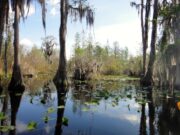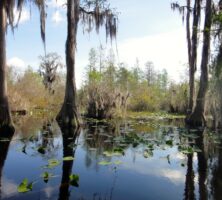The comic strip Pogo, created by Walt Kelly, ran in daily newspapers from 1948 to 1973. The strip was set in Georgia’s Okefenokee Swamp and was populated by animals talking in a fractured southern dialect.
Over the years Pogo often referred to Georgia and to several of the state’s locales, such as Waycross, Fort Mudge, and Ware County. In one story line, involving cold war themes, the swamp characters used the state as a counterpoint to the Soviet Republic of Georgia. Overall, Pogo provided the American newspaper-reading public with a humorously stereotyped view of southern life, complete with folksy sayings, strange food (such as chicken foot perloo), corncob-smoking females, and images of chivalrous southern manhood. For the animals of the Okefenokee, the Confederacy still existed, with Jefferson Davis as its president and Richmond, Virginia, its national capital.
For all its superficial identification with Georgia and the South, Pogo was a comic strip written by a northerner for a national audience. In the 1950s it was the most popular daily strip in America, primarily because of its blend of slapstick humor and engaging characters. It was unique for its occasional forays into political satire. Pogo’s most famous target in the 1950s was an odious wildcat named Simple J. Malarkey, who had the unmistakable face of U.S. senator Joseph McCarthy of Wisconsin. Kelly was one of the few cartoonists of the era willing to satirize McCarthy and his bullying tactics. In the spirit of cold-war liberalism, however, Kelly also lampooned the ideas and policies of communism by introducing into the strip a pig with Nikita Khrushchev’s face and a goat with Fidel Castro’s. Over the years Pogo also critiqued such controversial issues as the South’s resistance to desegregation and the turmoil surrounding the Vietnam War (1964-73). Editors would occasionally censor such topics, either by altering the strip’s artwork or by dropping certain political sequences altogether. Some editors simply began to run Pogo on the editorial page.
The comic strip’s popularity and satirical relevance began to fade during the 1960s. Some critics have contended that the middle-of-the-road liberalism of the previous decade, which had challenged McCarthyism and communism simultaneously, now appeared to be out of step with the complex problems of the decade.
After Kelly died in 1973, Pogo was continued for a while by Kelly’s children, Carolyn and Pete. The cartoon is still being reprinted in books. That the strip’s Okefenokee characters live on and are still fondly remembered is perhaps most visible each year in Waycross, which sponsors Pogofest, complete with arts and crafts, street dancing, and visits by well-known cartoonists. The celebration is a fitting commemoration of Pogo and its relationship with Georgia.






